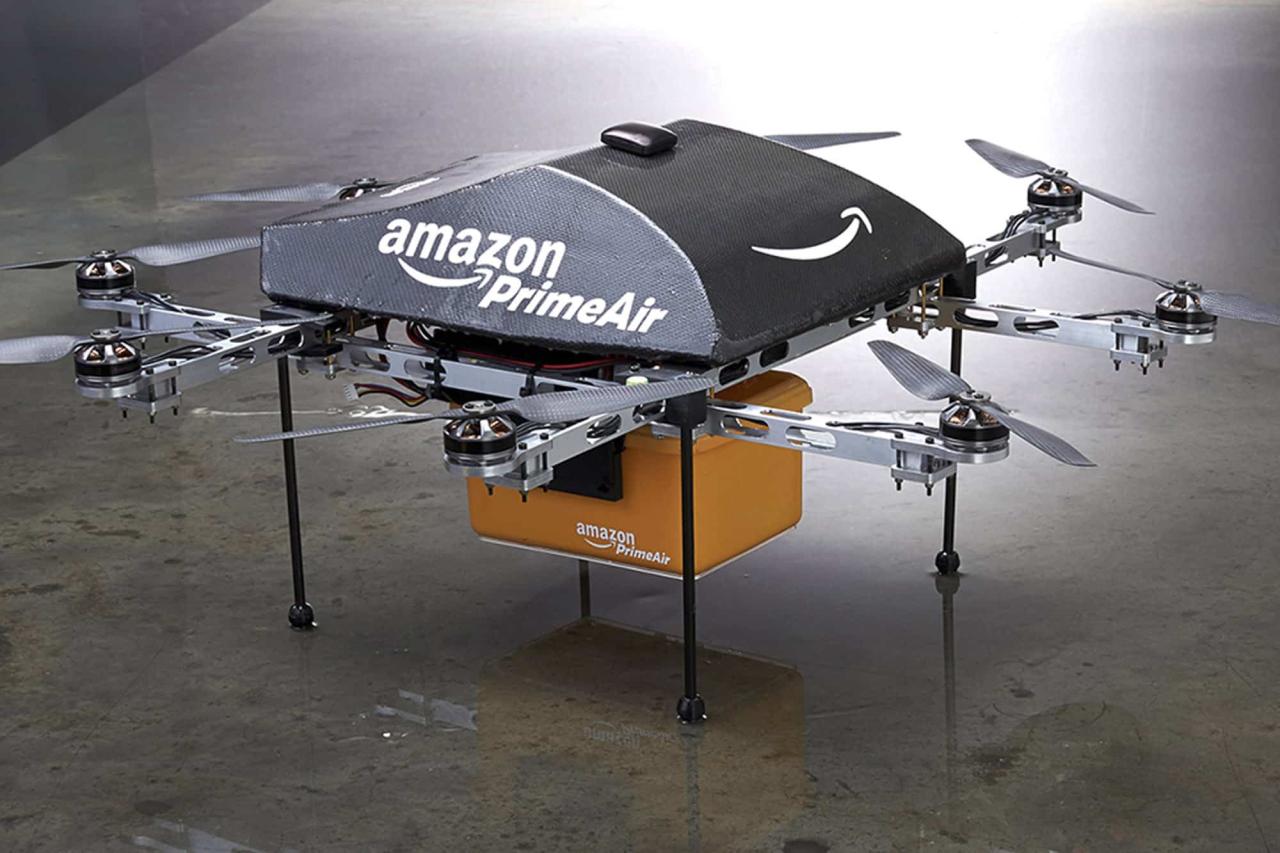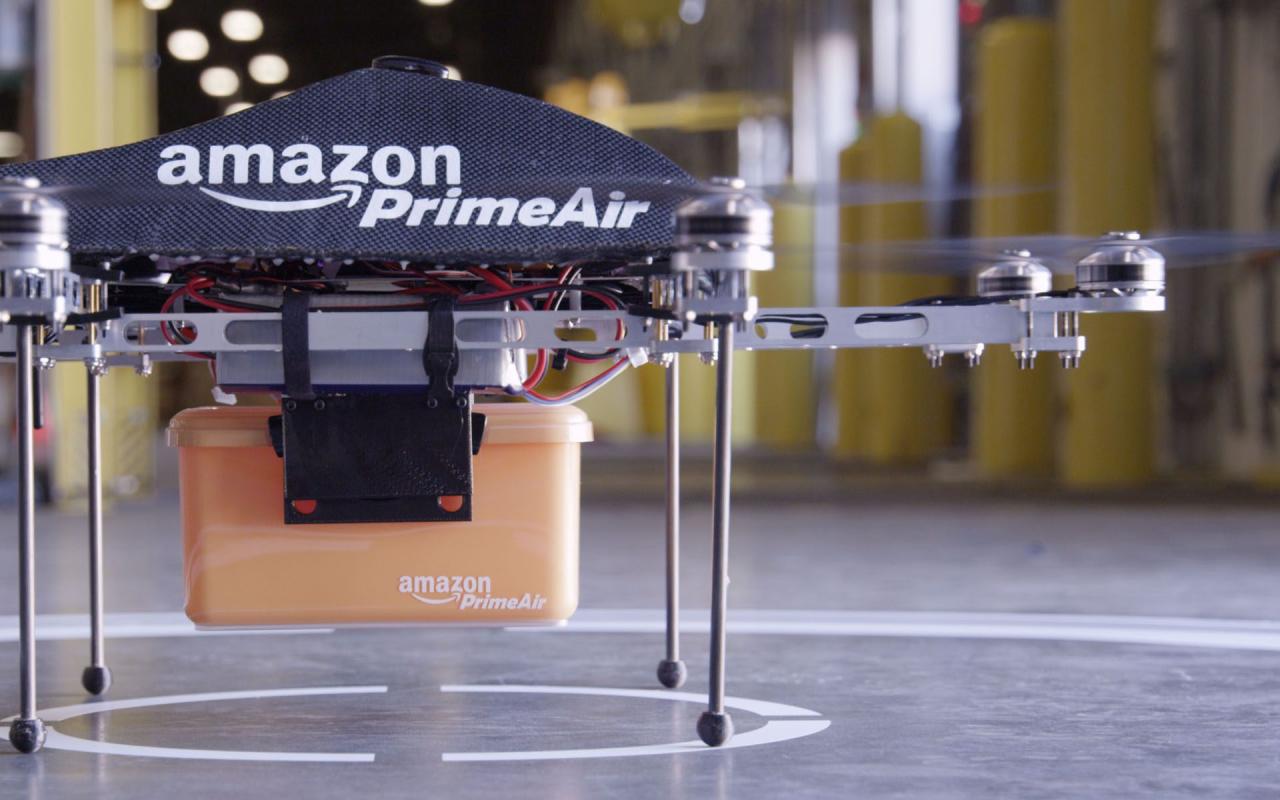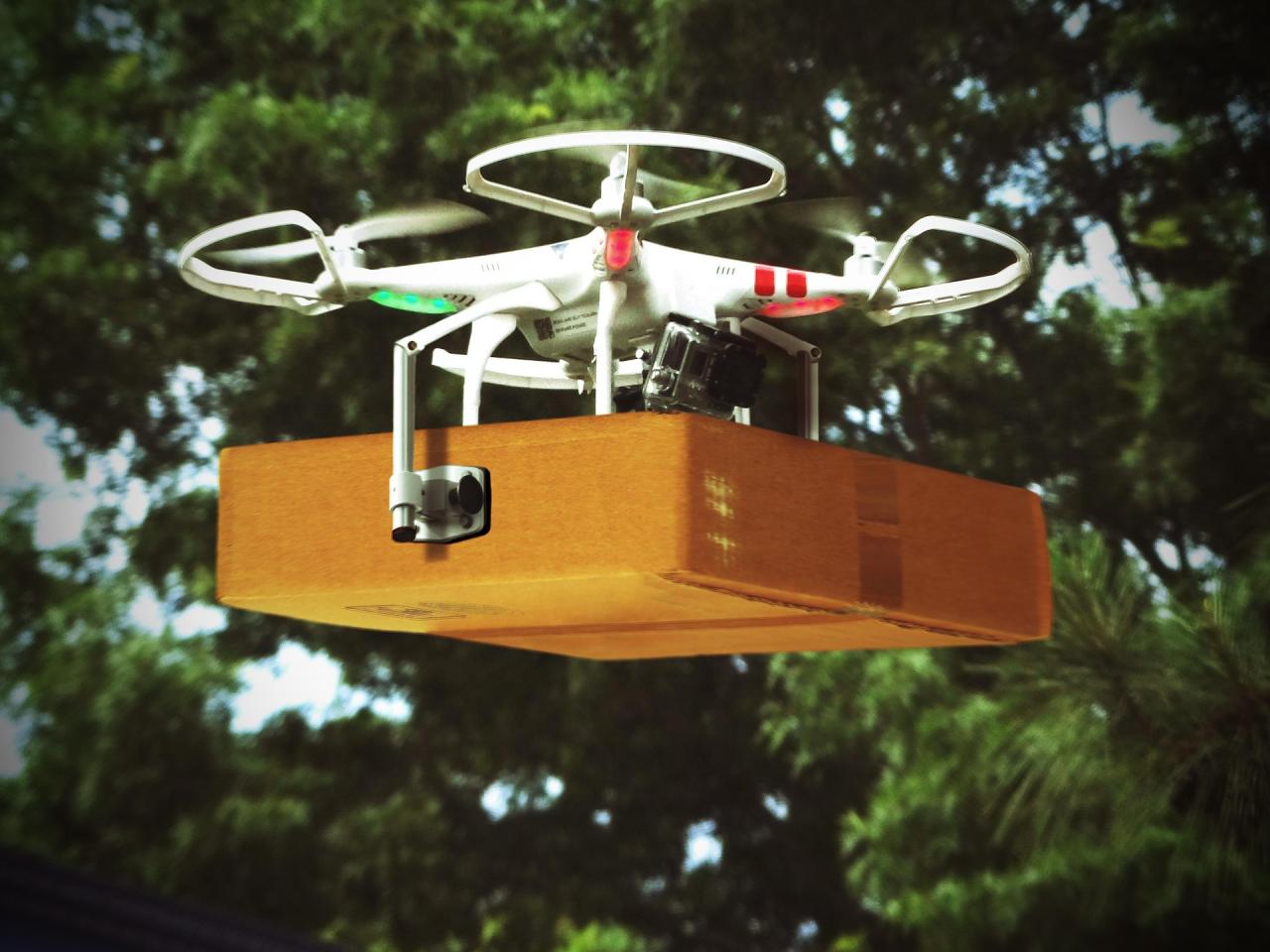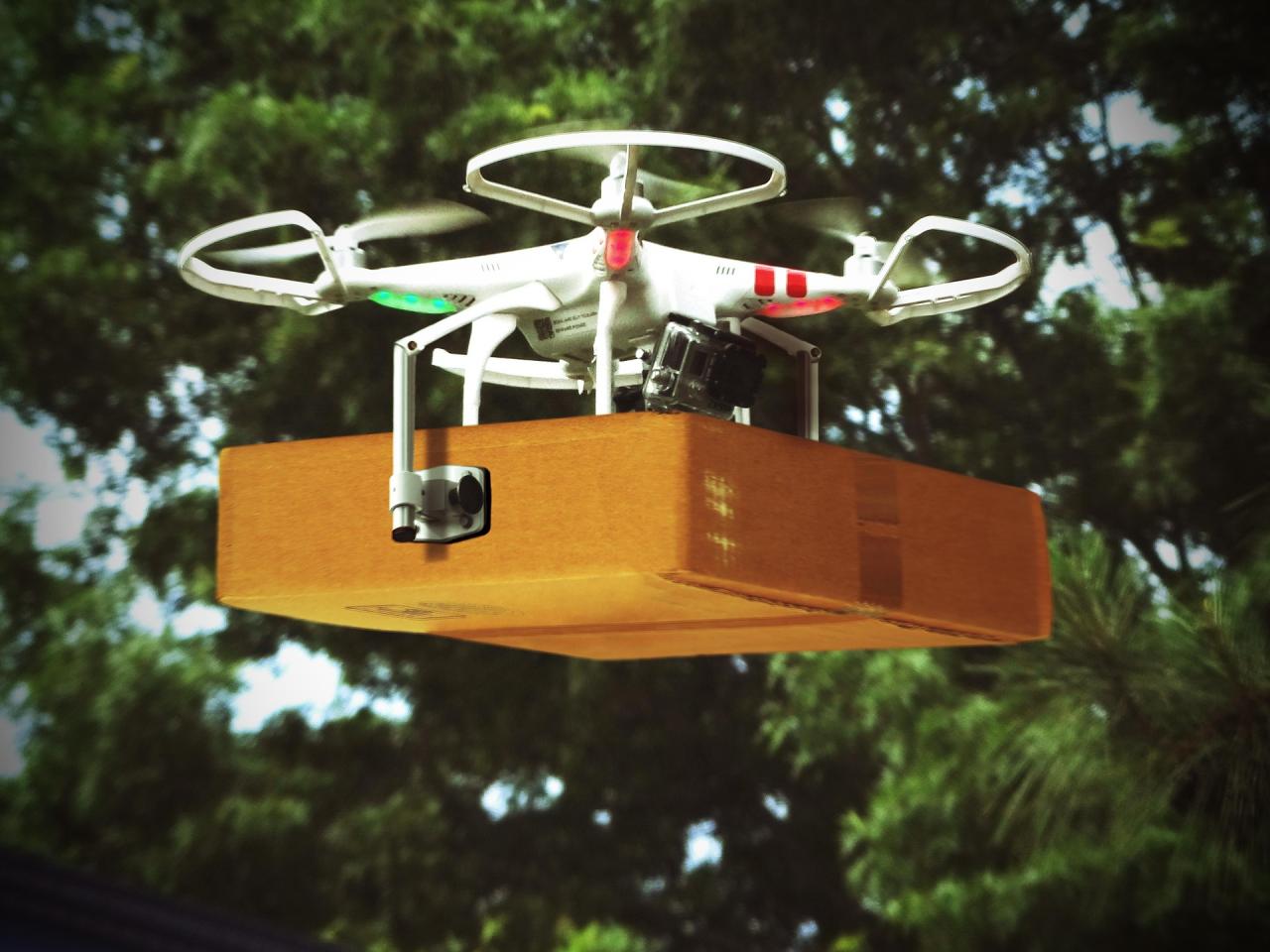Amazon drone delivery locations are rapidly expanding, revolutionizing how we receive packages. This innovative system, utilizing a network of strategically placed delivery hubs and sophisticated drone technology, promises faster and more efficient deliveries. But how does it all work? What factors determine where these locations are established? And what’s the future of this exciting delivery method?
Let’s explore.
This guide delves into the current status of Amazon’s drone delivery program, examining the geographic reach, eligible items, technological requirements, and key milestones achieved. We’ll also explore the logistical considerations behind location selection, including population density, infrastructure, regulations, and weather impacts. Finally, we’ll look at the customer experience, future expansion potential, and the environmental considerations of this emerging technology.
Current Amazon Drone Delivery Program Status: Amazon Drone Delivery Locations

Amazon’s drone delivery program, officially known as Amazon Prime Air, is steadily expanding its reach and capabilities, marking a significant step towards faster and more efficient delivery methods. While still in its relatively early stages, the program showcases the potential of drone technology to revolutionize last-mile delivery. This section details the current state of the program, including its geographical reach, eligible items, technological underpinnings, and key milestones.
Geographic Scope of Amazon Drone Delivery
Currently, Amazon Prime Air operates in a limited number of locations. The program’s geographic scope is constrained by factors such as regulatory approvals, airspace management, and infrastructure requirements. This means that drone delivery is not available nationwide, nor even in most states. Specific operational areas are typically announced by Amazon as they become active, and these areas tend to be smaller, less densely populated communities.
The company focuses on carefully selected locations to test and refine its operations before wider expansion.
Types of Items Eligible for Drone Delivery
The range of items eligible for Amazon Prime Air delivery is currently restricted. Only smaller, lighter packages are suitable for drone transport due to weight and size limitations of the drones themselves. These typically include everyday items such as books, small electronics, and household goods. Perishable goods are generally not included due to the need for temperature control and the potential impact of weather conditions on delivery times.
Amazon carefully selects products based on their suitability for drone transport and safety considerations.
Amazon’s expanding drone delivery network is covering more ground, aiming for convenient, fast delivery in select areas. However, the recent orlando drone show accident highlights the potential risks involved with drone technology, reminding us of the importance of safety regulations and technological advancements for safe and reliable drone operations. This incident underscores the need for robust safety protocols as Amazon continues to expand its drone delivery locations.
Technological Infrastructure for Drone Delivery
Amazon’s drone delivery system relies on a sophisticated technological infrastructure. This includes a network of drone hubs strategically located to optimize delivery routes and coverage. These hubs house charging stations, maintenance facilities, and drone control systems. Beyond the physical infrastructure, a robust communication network is crucial for real-time tracking and control of the drones. Amazon utilizes advanced sensors, GPS technology, and sophisticated algorithms to ensure safe and efficient flight operations.
The system also integrates with Amazon’s broader logistics network to manage orders and integrate drone deliveries into the existing delivery workflow.
Milestones in Amazon’s Drone Delivery Program
Amazon’s Prime Air program has reached several significant milestones since its inception. Early testing and development phases focused on perfecting drone technology and navigating regulatory hurdles. A key milestone was obtaining necessary approvals from aviation authorities to conduct drone deliveries in controlled environments. Subsequent milestones involved expanding the program’s operational area and gradually increasing the number of eligible items.
While specific dates for each milestone are not always publicly released, the ongoing expansion and refinement of the program demonstrate continuous progress towards broader deployment. The company regularly announces updates on its progress and future plans for Prime Air, suggesting a phased rollout rather than a sudden, widespread implementation.
Factors Influencing Location Selection for Drone Delivery
Choosing the right locations for Amazon’s drone delivery program is crucial for success. Many factors need careful consideration to ensure efficient and safe operations, balancing the benefits of drone delivery with practical limitations. These factors range from logistical challenges to regulatory requirements and environmental influences.
Logistical Factors in Location Selection
Several logistical factors heavily influence the selection of drone delivery locations. Population density directly impacts the potential customer base and the frequency of deliveries. Areas with higher population density, like city centers, offer a larger market but present challenges in navigating complex airspace and infrastructure. Conversely, lower density areas may have fewer customers but simpler airspace. Infrastructure plays a vital role; reliable communication networks (for drone control and tracking) and sufficient charging infrastructure are essential.
Amazon’s expanding drone delivery network is pretty cool, right? They’re testing in various locations, aiming for wider rollout. But before that happens, consider this: the recent reports about a mystery drone in Paris highlight the potential security and regulatory challenges involved in widespread drone use. Ultimately, figuring out how to manage all this is key to making Amazon’s drone delivery locations a success.
The existing road network also influences accessibility for drone maintenance and support. Finally, the availability of suitable takeoff and landing zones, free from obstacles and within safe distances from populated areas, is critical.
Urban vs. Suburban vs. Rural Drone Delivery Feasibility
Urban areas present unique challenges and opportunities for drone delivery. High population density creates a large potential customer base, but congested airspace, tall buildings, and complex infrastructure necessitate advanced drone technology and careful flight planning. Suburban areas offer a more manageable airspace, with generally lower population density and fewer obstacles, potentially simplifying delivery routes and reducing flight times.
However, the dispersed nature of suburban development may require more extensive flight paths. Rural areas, with their wide-open spaces and less congested airspace, seem ideal, yet the low population density might limit the economic viability of drone delivery operations in these locations. The optimal location depends on balancing the potential customer base with the operational challenges. For example, a dense urban center might justify the investment in advanced drone technology and air traffic management, while a sparsely populated rural area might require subsidies or integration with other delivery methods to be cost-effective.
Regulatory Hurdles and Approvals for Drone Delivery Locations
Establishing drone delivery locations requires navigating a complex regulatory landscape. Federal Aviation Administration (FAA) regulations govern drone operations, including airspace restrictions, pilot certifications, and operational safety standards. Securing necessary permits and approvals from the FAA is crucial before launching operations in any location. Local regulations, such as zoning laws and noise ordinances, may also impose restrictions on drone operations.
The process of obtaining all necessary approvals can be lengthy and complex, significantly impacting the timeline for establishing new drone delivery locations. Amazon, for example, has worked extensively with the FAA to obtain waivers and exemptions to operate beyond visual line of sight (BVLOS) for their drone delivery program, highlighting the significant regulatory hurdles involved.
Impact of Weather Conditions on Drone Delivery Operations
Weather conditions significantly impact the safety and feasibility of drone delivery operations. Adverse weather, such as strong winds, heavy rain, snow, or fog, can ground drones and disrupt delivery schedules. Locations with frequent inclement weather may require more robust drone designs and operational procedures, potentially increasing costs. Predicting weather patterns and incorporating real-time weather data into flight planning are crucial for ensuring the safety and reliability of drone deliveries.
For example, a location with frequent thunderstorms might necessitate the use of drones with advanced weather sensors and the implementation of contingency plans to reroute or postpone deliveries during periods of poor weather.
Infrastructure and Technology Required at Delivery Locations

Setting up successful Amazon drone delivery locations requires careful consideration of the necessary infrastructure and technology. These elements ensure safe, efficient, and reliable drone operations, ultimately leading to a smooth customer experience. This section details the key components and systems involved.
Essential Infrastructure Components
The following table Artikels the essential infrastructure components needed at each Amazon drone delivery location. These components work together to facilitate the entire delivery process, from drone landing and charging to communication and package handling. Regular maintenance is crucial for optimal performance and safety.
| Component | Description | Required Quantity | Maintenance Needs |
|---|---|---|---|
| Landing Pad | A designated area for drones to land and take off safely, often incorporating features like lighting and markings for precise positioning. Ideally, it should be a level, unobstructed surface of sufficient size to accommodate the drone’s dimensions and maneuvering space. | At least 1, potentially more depending on anticipated delivery volume. | Regular inspection for damage, cleaning, and potential repairs or replacements as needed. Ensuring adequate lighting functionality is also critical. |
| Charging Station | A system for recharging drone batteries, typically including power supply, charging connectors, and potentially battery management software. This ensures drones are always ready for their next delivery. | Multiple stations depending on the number of drones operating from the location and their flight times. | Regular checks of power supply, connector integrity, and software updates to ensure efficient and safe charging. |
| Communication System | A network of antennas and communication equipment for maintaining constant communication between drones and the central control system. This allows for real-time tracking, flight control, and data transmission. | Multiple antennas strategically positioned to ensure coverage across the entire operational area. | Regular maintenance, software updates, and potential upgrades to enhance network capacity and reliability. |
| Package Handling System | A system for secure storage and retrieval of packages, including secure containers, automated sorting mechanisms (potentially), and systems for managing package inventory. | At least one secure storage area, potentially with multiple compartments for organization. | Regular cleaning, maintenance of storage containers, and software updates for inventory management systems. |
Drone Communication Technologies
Several communication technologies are used to track and manage drones in flight. These systems work in conjunction to ensure reliable communication and precise control, even in challenging environments. Examples include GPS for location tracking, cellular networks for data transmission, and dedicated radio frequencies for direct drone control. Redundancy in communication systems is crucial to mitigate potential failures.
Package Delivery and Retrieval System
The system for handling package delivery and retrieval involves a combination of automated and manual processes. Drones deliver packages to designated locations within the delivery zone, often utilizing secure drop-off mechanisms. Upon delivery, the system records successful delivery and updates the central system. For retrieval of packages, a combination of automated systems (if available) and manual handling may be used, depending on the complexity and scale of operations.
This system prioritizes security and efficiency to ensure reliable and prompt delivery.
Safety Protocols and Emergency Procedures, Amazon drone delivery locations
Safety is paramount in drone delivery operations. Each location implements comprehensive safety protocols and emergency procedures. These include regular safety checks of drones and infrastructure, pre-flight inspections, real-time monitoring of drone flights, and emergency response plans for scenarios such as drone malfunctions or unexpected weather conditions. Fail-safe mechanisms within the drones themselves, such as automatic landing systems, also play a crucial role in mitigating risks.
Emergency contact information and procedures are readily available at each location.
Customer Experience and User Interaction with Drone Delivery

Amazon’s drone delivery service aims to provide a seamless and convenient experience for customers. The entire process, from order placement to package retrieval, is designed for simplicity and ease of use, although the specific experience may vary depending on location and package type. This section details the customer journey and how feedback shapes the service’s evolution.
The customer experience begins with placing an order through the Amazon app, just like a standard order. If the delivery address is within the drone delivery service area, customers will see the option for drone delivery at checkout. Eligible items are clearly indicated. Once the order is placed, customers receive regular updates via the app, including estimated delivery windows and real-time tracking of the drone’s progress.
This transparency keeps customers informed and reduces anxiety about the delivery.
Drone Delivery Notification and Package Retrieval
Upon the drone’s arrival, customers receive a notification on their Amazon app. This notification often includes a visual representation of the drone’s location and a countdown to delivery. The drone then autonomously descends and gently lowers the package into a designated delivery zone, often a customer’s backyard. The package is secured and easily accessible. The customer can then retrieve their package and confirm delivery within the app.
Step-by-Step Guide for Preparing for a Drone Delivery
Preparing for a drone delivery is straightforward. Here’s a step-by-step guide:
- Ensure your delivery address is within the Amazon drone delivery service area. This information is readily available on the Amazon website and app.
- Check that your delivery location is suitable. The delivery area needs to be a safe, open space free from obstructions, such as tall trees, power lines, or other hazards. A clear, flat area is ideal.
- Keep pets secured during the scheduled delivery window. This ensures the safety of your pets and prevents any interference with the delivery process.
- Monitor the Amazon app for delivery updates and notifications. This allows for real-time tracking and preparation for package retrieval.
- Retrieve your package once the delivery is complete and confirm receipt through the app.
Customer Feedback and Service Optimization
Amazon actively solicits customer feedback through in-app surveys and reviews. This feedback plays a crucial role in optimizing drone delivery locations and procedures. For example, if customers consistently report difficulties retrieving packages due to uneven terrain or obstacles, Amazon may adjust the delivery zone or consider alternative delivery methods for that specific location. Negative feedback about the notification system might lead to improvements in the app’s notification features, ensuring customers receive timely and accurate updates.
Conversely, positive feedback reinforces successful practices and informs the expansion of the drone delivery service to new areas. This iterative process of data collection and service refinement is key to enhancing the overall customer experience.
Future Expansion and Potential of Amazon Drone Delivery
Amazon’s drone delivery program, currently operating in select areas, holds immense potential for future expansion and significant impact on the logistics industry. Its success hinges on overcoming various challenges while leveraging technological advancements to create a more efficient and environmentally conscious delivery system.The expansion of Amazon’s drone delivery network will likely involve a phased approach, focusing on areas with suitable infrastructure and regulatory frameworks.
Initially, we can expect growth within existing operational regions, increasing delivery density and expanding the range of products offered via drone. Subsequently, expansion into new geographic areas, particularly those with lower population densities and less congested airspace, will be prioritized. This strategic approach allows Amazon to refine its operations and gather crucial data before tackling more complex urban environments.
Geographic Expansion Strategies
Amazon’s expansion strategy will likely involve careful consideration of factors like population density, existing infrastructure (including suitable landing zones and network connectivity), and local regulations. Areas with robust digital infrastructure and less stringent airspace regulations will likely be prioritized for early expansion. We might see a focus on suburban and rural areas initially, where drone delivery can offer a significant advantage over traditional ground transportation.
Later, the company will likely target densely populated urban areas, but this will require overcoming challenges related to air traffic management and public acceptance. The rollout will likely be gradual, focusing on proving the safety and reliability of the system in each new area.
Challenges to Future Expansion
Several hurdles could impede the widespread adoption of Amazon’s drone delivery system. Regulatory changes are a significant factor; varying airspace regulations across different countries and regions can create complexities and delays. Technological advancements, while crucial for progress, also present challenges. Ensuring the reliability of drone technology in diverse weather conditions and addressing issues like battery life and payload capacity are ongoing priorities.
Amazon’s planning drone delivery locations is a huge undertaking, needing careful consideration of airspace and population density. Recent incidents, like the one detailed in this article about a paris drone crash , highlight the safety challenges involved. Understanding these risks is crucial for successfully implementing widespread Amazon drone delivery locations.
Public acceptance and addressing safety concerns are also paramount. Amazon will need to demonstrate the safety and reliability of its drone delivery system consistently to build public trust. Finally, the integration of drone delivery into existing logistics networks will require careful planning and coordination.
Vision for the Future of Drone Delivery
The future of drone delivery likely involves seamless integration with other technologies. For instance, we can envision drones working in conjunction with autonomous vehicles for last-mile delivery, with drones handling the final delivery to a customer’s doorstep while autonomous vehicles transport packages to designated drop-off zones. Advanced AI and machine learning will enhance drone navigation and route optimization, leading to increased efficiency and reduced delivery times.
Real-time tracking and predictive analytics will allow for improved delivery scheduling and proactive issue resolution. The use of drones for deliveries will become more commonplace, integrated into our daily lives like any other form of delivery. Imagine a future where your Amazon order arrives by drone in under an hour, regardless of your location.
Environmental Impact and Mitigation Strategies
While drone delivery offers advantages in terms of speed and efficiency, its environmental impact must be carefully considered. The energy consumption of drones, particularly battery production and disposal, needs to be minimized. Amazon is likely to explore strategies such as using renewable energy sources to power its drone fleet and developing more efficient drone designs with longer battery life and reduced emissions.
Sustainable packaging materials and efficient delivery routes will also play a significant role in minimizing the overall environmental footprint. Companies may invest in research and development of electric vertical takeoff and landing (eVTOL) aircraft to reduce reliance on fossil fuels and lessen the impact of noise pollution. This could include collaborating with manufacturers and researchers to develop more eco-friendly battery technology.
Data-driven optimization of flight paths and delivery schedules will also minimize fuel consumption and emissions.
Wrap-Up
Amazon’s drone delivery program represents a significant leap forward in logistics and convenience. While challenges remain in terms of regulation, infrastructure, and technological refinement, the potential for widespread adoption and expansion is undeniable. As the technology matures and regulatory frameworks adapt, we can expect to see a significant increase in the number of Amazon drone delivery locations, bringing faster and more efficient deliveries to an ever-growing number of customers.
The future of package delivery is taking flight.
Common Queries
How long does a drone delivery take?
Delivery times vary depending on distance and weather conditions, but generally aim for 30-60 minutes.
What if my drone delivery is delayed?
Amazon provides updates through the app. Contact customer service for assistance with delays.
Can I track my drone delivery?
Yes, you can track your drone’s location in real-time through the Amazon app.
What happens if the drone malfunctions during delivery?
Amazon has safety protocols in place. In case of a malfunction, the drone will attempt a safe landing, and customer service will be notified.
Are there any weight or size restrictions for drone deliveries?
Yes, there are weight and size limitations; check the Amazon website for details on eligible items.
